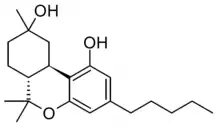9-Hydroxyhexahydrocannabinol
9-Hydroxyhexahydrocannabinol (9-OH-HHC) is a semi-synthetic derivative of tetrahydrocannabinol. It is formed as an impurity in the synthesis of Delta-8-THC,[1] and retains activity in animal studies though with only around 1/10 the potency of Δ9-THC, with the 9α- and 9β- enantiomers having around the same potency.[2]
 | |
| Identifiers | |
|---|---|
IUPAC name
| |
| CAS Number |
|
| PubChem CID | |
| ChemSpider | |
| Chemical and physical data | |
| Formula | C21H32O3 |
| Molar mass | 332.484 g·mol−1 |
| 3D model (JSmol) | |
SMILES
| |
InChI
| |
See also
- 9-Nor-9β-hydroxyhexahydrocannabinol
- 11-Hydroxyhexahydrocannabinol
- 11-Hydroxy-THC
- 11-Hydroxy-Delta-8-THC
- Cannabicitran
- Cannabitriol
- Delta-10-THC
- Hexahydrocannabinol
References
- Garrett ER, Gouyette AJ, Roseboom H (January 1978). "Stability of tetrahydrocannabinols II". Journal of Pharmaceutical Sciences. 67 (1): 27–32. doi:10.1002/jps.2600670108. PMID 22740.
- Reggio PH, McGaughey GB, Odear DF, Seltzman HH, Compton DR, Martin BR (November 1991). "A rational search for the separation of psychoactivity and analgesia in cannabinoids". Pharmacology, Biochemistry, and Behavior. 40 (3): 479–86. doi:10.1016/0091-3057(91)90350-b. PMID 1806940.
This article is issued from Wikipedia. The text is licensed under Creative Commons - Attribution - Sharealike. Additional terms may apply for the media files.